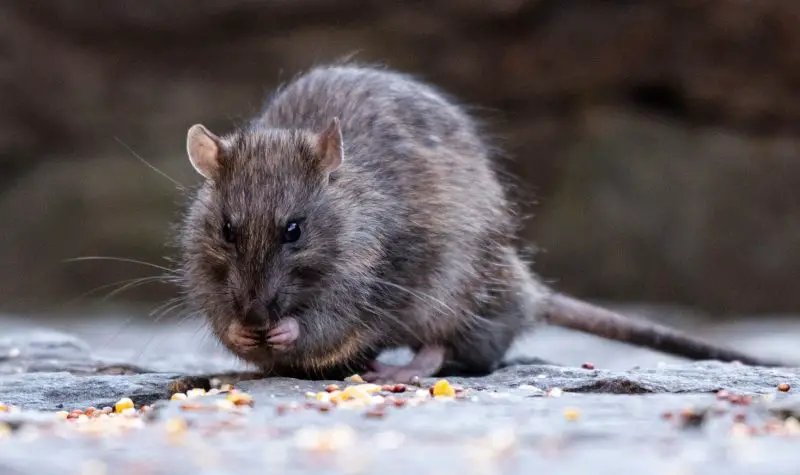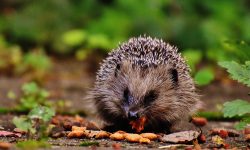Rats are some of the most adaptable animals on the planet, able to survive in forests, fields, cities, farms, and nearly every environment humans occupy. Their diet is a key part of that success. Rats consume a wide range of foods, from fresh vegetation to insects and stored grains, allowing them to thrive even when resources shift with the seasons.
In the wild, rats spend much of their time searching for nutrient-rich foods that provide energy, hydration, and minerals. Their strong teeth and keen sense of smell make them efficient foragers capable of chewing through tough plant material, cracking seeds, or tracking down small prey when plant foods become scarce.
Understanding what rats eat not only reveals how they thrive in the wild but also helps people recognize their ecological role — and why they are so good at surviving alongside humans. Below is the most detailed breakdown of the rat diet, including a complete list of the 20 foods rats love the most.
Understanding the Rat Diet

A flexible omnivorous system
Rats are natural omnivores with digestive systems capable of processing plants, seeds, fruits, insects, and even small animals. Their stomach and intestines extract nutrients efficiently from both fibrous vegetation and protein-rich prey, giving them an advantage in environments where food availability changes quickly.
Seasonal and habitat-based food selection
Wild rats shift their diet depending on rainfall, temperature, and habitat. In forests, they often feed on nuts, berries, roots, insects, and fungi. In grasslands they consume seeds, roots, and occasional small animals. Near human areas they exploit grain stores, discarded food, and crops. This adaptability helps them survive in almost any environment.
Hydration and nutrient balance
Rats get most of their hydration from fresh foods such as fruits, insects, and succulent plants. This reduces their need for open water sources, allowing them to thrive in dry climates or urban areas where water may be limited. Their diet provides a mix of carbohydrates, fats, proteins, and minerals that fuel their high metabolism and constant movement.
20 Foods Rats Love the Most
1. Seeds
Seeds are one of the most important foods in a wild rat’s diet. They provide dense calories, healthy fats, and essential minerals that support bone and muscle development.
Rats often forage for seeds early in the morning and at dusk, collecting and storing them in burrows. Their sharp incisors allow them to crack open even tough seed shells with ease.
When seed supplies peak in late summer and fall, rats gain extra energy that helps them survive winter months with limited vegetation.
2. Grains
Grains such as wheat, rice, oats, and barley are some of the richest food sources available to rats. These carbohydrate-packed foods supply the energy rats need for constant foraging and movement.
In agricultural areas, rats often gather spilled grain or harvest kernels directly from fields. Their ability to climb and dig gives them access to stored grain as well.
Grain-heavy diets help rats reproduce more quickly, supporting the rapid population growth seen in farm regions.
3. Fruits
Wild rats eagerly eat fruits like apples, berries, cherries, and figs. Fruits provide natural sugars that deliver quick energy for climbing, running, and escaping predators.
Their high moisture content also keeps rats hydrated without needing direct water sources. Many rats consume fallen fruit from forest floors or orchards.
Because fruits are seasonal, rats increase their intake during late summer when availability peaks.
4. Vegetables
Leafy greens, roots, and tender shoots are essential parts of a rat’s diet. They supply fiber that regulates digestion and prevents blockages.
Rats commonly eat wild spinach, carrot tops, leafy weeds, and young plant stems. These foods are abundant in wetter months, allowing rats to consume large amounts quickly.
The vitamins found in vegetables support immune health, helping wild rats survive harsh outdoor conditions.
5. Nuts
Nuts such as acorns, walnuts, and hazelnuts are prized by wild rats. They are calorie-dense and provide healthy fats for long-term energy storage.
Rats often hoard nuts in underground chambers, saving them for times when food becomes scarce. Their strong teeth can easily break through tough nutshells.
Nuts also contain trace minerals that support growth and reproductive health in wild rat populations.
6. Insects
Insects provide protein and fat, making them extremely valuable for rats living in natural habitats. Beetles, crickets, grasshoppers, and moth larvae are among the most common prey.
Rats hunt insects using their sharp hearing to detect movement under leaves or soil. Their quick reflexes help them capture even fast-moving bugs.
Insects are especially important for young rats that need protein to grow quickly.
7. Worms
Earthworms are a soft, easy-to-digest protein source for rats. They are abundant after rainfall and require little energy to capture.
Rats dig shallow holes or search under rocks and logs to find worms. The moisture worms contain helps keep rats hydrated.
This prey item is especially common in forested and garden environments.
8. Small Fish
Some rat species living near rivers, lakes, or marshlands occasionally feed on small fish. They may catch slow, shallow-swimming fish or scavenge on dead ones.
Fish provide essential omega fats that support brain and nerve function. They also offer high moisture content.
This opportunistic feeding behavior is more common in tropical and coastal regions.
9. Small Birds
When vegetation is scarce, rats may prey on small birds or nestlings. They use stealth to approach nests and rely on speed during attacks.
Birds provide a protein-rich meal that fuels high activity levels. Their bones and organs also contain minerals rats need.
Though not a primary food, birds serve as an important seasonal supplement.
10. Eggs
Rats often raid nests for eggs, which are easy to break and full of nutrients. Eggs supply fats, proteins, and moisture in one compact meal.
In the wild, rats target ground-nesting birds or reptiles. They may carry eggs back to burrows for future consumption.
Egg availability varies, but rats exploit this resource whenever possible.
11. Roots
Rats dig for roots during winter or drought when surface food becomes limited. Roots provide slow-release energy through complex carbohydrates.
They commonly eat wild carrot roots, yam-like tubers, and soft plant rhizomes. These foods are especially important in cold regions.
Roots help maintain stable energy levels during lean seasons.
12. Bark
Bark scraping occurs when rats struggle to find fresh vegetation. They gnaw on soft tree bark to access inner tissues rich in sap.
This source provides hydration and fiber, helping keep digestion active. It also helps rats manage constant tooth growth.
Bark feeding is mostly observed in winter or severe drought.
13. Fungi
Mushrooms and other fungi appear in damp forests and provide moisture and trace minerals. Rats consume both wild fungi and decaying fungal matter.
These foods help regulate nutrient balance during rainy seasons. Some rats selectively choose species based on smell and texture.
Fungi-rich diets are common in shaded woodland habitats.
14. Snails
Snails are protein-rich and easy prey for rats, especially after rain. Their slow movement makes them simple to catch.
Rats break shells or swallow smaller snails whole. Snail tissues contain minerals that promote strong bone development.
This behavior helps rats maintain protein intake during plant scarcity.
15. Slugs
Slugs are another soft-bodied prey source. Rats track them at night or early morning when they are most active.
Their water-filled bodies provide hydration in dry environments. Slugs are especially important in gardens, forests, and moist fields.
Rats consume them whole, gaining quick protein without much effort.
16. Carrion
Rats often scavenge on dead animals when fresh food is limited. Carrion provides high fat and protein content.
Their strong stomach acids allow them to digest decayed meat without harm. This makes them effective survivors in harsh environments.
Carrion feeding also reduces the need for risky hunting.
17. Human Food Scraps
In urban and suburban areas, rats frequently eat leftover human food. Bread, rice, fruit peels, and meat scraps become part of their opportunistic diet.
These foods supply easy calories and help rats reproduce quickly near human settlements. Their strong noses lead them directly to trash or compost piles.
Rats thrive wherever human waste provides constant food supplies.
18. Pet Food
Rats often consume spilled pet food outdoors. Dog and cat kibble contains proteins and fats ideal for rat survival.
Because pet food is highly nutritious and calorie-dense, it supports rapid growth and breeding. Rats often return nightly to feeding stations they locate.
This behavior is common in suburban areas with outdoor pets.
19. Agricultural Crops
Fresh crops like corn, soybeans, sweet potatoes, and peanuts attract wild rats. These plants provide carbohydrates, oils, and hydration.
Rats feed on both roots and above-ground portions depending on growth stage. Crop-rich regions often support large rat populations.
This diet diversity allows rats to survive seasonal fluctuations in wild vegetation.
20. Nutsedge Tubers
Nutsedge plants produce small underground tubers known as “nutlets.” Rats dig for these starchy foods when other resources decline.
Nutlets are rich in carbohydrates and easy to store in burrows. Their abundance in wetlands and fields makes them reliable seasonal foods.
These tubers play a major role in sustaining rats during winter or drought.
FAQs
Do rats drink water?
Yes, but much of their hydration comes from food sources like fruits, insects, and vegetation.
Are rats strictly omnivores?
Rats are true omnivores, capable of eating plants, insects, small animals, and scavenged foods.
Do rats eat meat?
Yes. They eat insects, small birds, fish, eggs, and carrion when plant foods are scarce.
What foods help rats survive winter?
Seeds, nuts, stored roots, bark, and scavenged meat provide essential winter calories.
Do rats eat human food?
Absolutely. In urban areas, discarded human foods make up a large part of their diet.
Do rats eat garden plants?
Yes. They nibble vegetables, roots, fruits, and tender shoots when available.
Do rats hunt?
They can. Rats occasionally catch insects, worms, small birds, and nestlings.
What attracts rats most?
High-calorie foods like grains, fruits, nuts, and stored human food attract them easily.
Do rats store food?
Yes. Rats create storage chambers to save seeds, nuts, and roots.
What is a rat’s favorite food?
Seeds, grains, and fruits rank among their most preferred and energy-rich foods.
Final Thoughts
Rats survive in nearly every corner of the world because of their incredible dietary adaptability. Whether they’re foraging for seeds in the wild, hunting insects at night, or scavenging near human homes, rats use their sharp senses and strong teeth to make the most of every environment. Their flexible diet helps them thrive through seasonal changes, habitat shifts, and food scarcity. Understanding what rats eat provides deeper insight into their biology, their role in ecosystems, and the reasons they continue to be one of the most successful animals on Earth.






